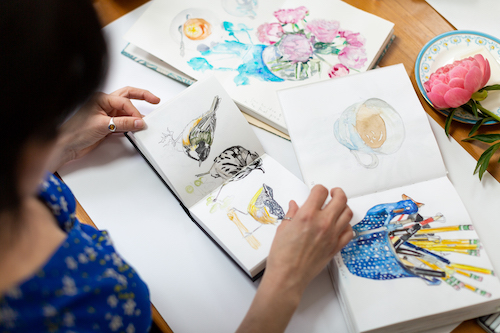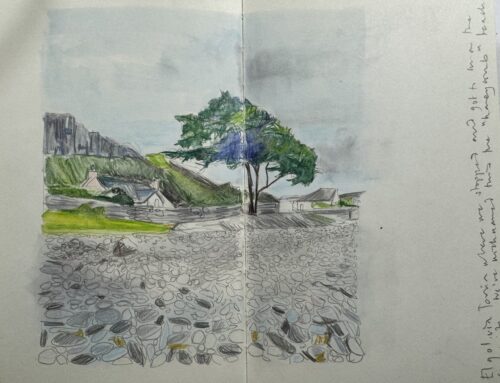Really? Can you really master how to draw anything? Is this possible?
When I started back into a drawing routine I found myself following (and stalking!) artists I deeply admired. I found that I went right back to their beginnings perhaps to glean encouragement that if they could do it so could I.
Everyone has to start somewhere, even the people that show natural aptitude.
I believe that it is possible to draw anything. That’s to say that it’s possible to draw anything you want to draw.
I push myself to try mastering daunting drawing subjects where possible. My weekly free live sessions often see me tackling themes I’ve not spent much time drawing before. Attend a few of these and you’ll believe you can draw anything!
Drawing “anything” doesn’t just happen overnight though.
Gustave Flaubert’s comment that “you don’t make art out of good intentions” echoes across the historic halls of artistic greatness. You have to get focused with how you master certain techniques. It is simply not enough to just want to be able to do something, you must step beyond “good intentions,” roll up your sleeves and get practical!
Vincent Van Gogh in a letter to his brother Theo one November morning mused;
“There are laws of proportion, of light and shadow, of perspective, that one must know in order to be able to draw anything at all. If one lacks that knowledge it will always remain a fruitless struggle and one will never give birth to anything…” Vincent Van Gogh, A Life in Letters. p39. 1 November 1880.
Van Gogh’s beginnings are well documented as embryonic forays into the art world. It was only after 24 months of solid practice, blood, sweat and tears that his style started to emerge. You can see his progress in an earlier article I penned here on drawing the human figure.
I think this is why I like him so much as an artist. His journey is there for all to see. His sheer determination to succeed is what made him a great artist.
In order to “give birth” to your drawing and to, indeed, learn how to draw anything, there are a couple of core components to bear in mind.
Table of Contents
Mindset. Build Your Confidence, Set Your Intention and De-mystify!
To be able to draw “anything” seems a lofty claim to be making. Those that make it exude the confidence with which to be able to make it.
Where does the confidence to make such a claim come from? You may be reading this and thinking that it is your personal aspiration to be able to draw anything.
The mindset with which you approach your drawing skill is bound up in daily practice, patience, persistence, curiosity and so on. Furthermore these are further compounded by the consistency with which you need to apply yourself to learn. You must also cease in dwelling in the camp of “I can’t possibly draw that” to “I’m going to give it a go,” flipping from the eternal pessimist to optimist.
Almost like starting a diet, or wanting to integrate a new habit into your life, you must pave your way with focused intent. Good intentions are not enough, they need to be practical and focused.
My third point with regards to mindset is that you must de-mystify the perceived art of drawing. Essentially drawing revolves around the process you employ and how you decide to put a mark down on paper. That is it. Your personal alchemy on the page will emerge as your confidence grows. You will establish your own process of drawing and build step by step on your foundations.
What do you need to do get started then?
Equip yourself!
To be able to master how to draw anything implies that there are certain inherent rules, or laws that relate to every single thing we draw. Regardless of its complexity.
Start by doing a little bit of background research into the types of things you need to consider when drawing.
Equipment comes into this. Pencil and paper are your starting points. Always aim for a softer pencil and a hot pressed or cartridge paper to be able to make your mark. Thats all you really need to get started.
Avoid loading up on too much equipment, (and there is a lot out there). It can lead to overwhelm which could lead to “rabbit in the headlight” syndrome. You can easily find yourself stuck before you get going.
I make some suggestions about the kit you need to think about when starting a sketchbook here.
Plan to Learn.
Set aside some dedicated time each day to draw. I started with 10 minutes. Some days you will have longer and some days not so much.
In planning to learn you are far more likely to build a solid habit that becomes part of your daily schedule.
I always think that for too long we have treated our creativity as a hobby and not as an integral part of who we are to support how we do our living. As Julia Cameron cites in chapter 3 of (her sequel to The Artist’s Way) Walking in this World, “cultural mythology permeates our thinking about art and artists. Art is a tonic and medicinal for us all!” We just have to learn how to integrate it into our daily lives.
If you are starting to learn how to draw anything I believe you need to re-define how you have perceived being creative in your daily life. No more hobbyist mentality. Allow your creativity to sprout wings and move across your days and week.
Mindset.
I like to use a very personal sketchbook to draw in to overcome some of the mindset challenges I face when learning. Treat your drawing practice as a learning process. No-one needs to see it. I can fill it to my heart’s content with scribbles and thoughts, notes and odd looking drawings which in hindsight encourage how far I have come when I flip back through my drawings.
Firstly, embrace the Ps.
Abandon the notion of perfectionism.
Acknowledge procrastination (more on this pesky little subject here)
Embrace the mindset you need to practice. Commit whatever you feel is realistic. If it’s joining me every Wednesday as your dedicated drawing time use this as a starting point.
Secondly, luxuriate in making lots of mistakes consciously. This means that you should learn to embrace your mistakes as part of a wider learning process. Make them with the view to noting what doesn’t look or feel right. So, for example, my current drawing challenge is drawing the human head in proportion to the rest of the body. I am striving to work out a dedicated methodology to help me work this out. I’ve drawn some pretty misshapen heads. Whereas I used to abandon this after one or two goes, do a Van Gogh and be merciless in your pursuit of being happy with the drawing you produce.
Your Eyes!
In the first week of my Back to Basics course where you start your journey of drawing I spend a lot of time discussing how you draw with your eyes.
We spend too much time obsessing with how we mark our pages with our pencil. This may have been how you were traditionally taught. What I have realised as I have progressed is that I spend more time looking at my object now than at my piece of paper. You can master how to draw with your eyes and feel along the edges or contours of your object and translate it onto paper. (This comes with practice.)
Relying on what you see as opposed to your own interpretation of an object is the first golden rule to learning how to draw anything. A line is a line. Whatever, however, wherever….still a line. Drawings are a series of lines.
The first starting point before we even get to the technical aspects of drawing relates to how you look at the object, or thing you are drawing.
Kimon Nicolaides in his cult classic the Natural Way to Draw expounds upon the fact that drawing has;
…”nothing to do with artifice or technique. It has nothing to do with aesthetics or conception. It has only to do with the act of correct observation, and by that I mean a physical contact with all sorts of objects through all the senses.”
Correct observation depends on how you use your sight to transcribe an interpretation of what you see.
Make a note of how you look at what you are drawing!
Technique
How do you know that you can’t draw if you’ve never been shown how to?
We always assume that we are either born with this skill. At the end of the day drawing is a skill that you can learn. It’s an expression of our creativity. Over time you develop and refine your technique whilst applying the skill you have learned to develop your creative style.
I believe that there is a logical step by step process when it comes to learning how to draw that consists of 5 core components.
Working through each core component separately will help you break down how to draw. When you then learn to combine all 5 components you are en route to learning how to draw anything.
You can read about these 5 core components here.
And last but not least we come to practice.
Believe it or not there is an art to practice. I spent a lot of time delving into this subject in relation to learning to draw.
As a culture we have become refined to produce output. We work daily to get things done, whether at work, decorating our homes, booking a holiday and so forth. I talk about the different performance zones directly linked to how productive our approach to practice is likely to be.
Practicing to learn something is different to practising to produce output. Practice as part of a journey as opposed to a finished output (I.e a piece of artwork) is very often the thing we need to reconcile in our minds. If I said to you that I want you to practice to appreciate the process as opposed to create a piece of artwork would that change your confidence, improve your success rate, as well as relieve the pressure to “produce?” I think it would.
You can learn more about my experience and thoughts on practice here!
It helps to have a goal to focus your attention on.
A simple one if you are a beginner is to set yourself a task such as filling a sketchbook in 5 or 30 days with a small and simple daily drawing.
Or come and hang out with me in my weekly free live sketch sessions. You can catch up on a lot of them and a variety of different subjects that I cover over on my learning platform here.
Some final thoughts.
There is a mix of ingredients to get right when approaching how to draw anything.
I could no doubt write a book about it.
The trick is understanding what those ingredients need to look like for you and where to start your learning journey.
We also MUST challenge our pre-conceived notions of what being creative means. Re-programming our belief that we can create something we love on paper with our pencils as the outcome of a learning journey is part of the fun. There are no standards against which to measure yourself, just the want to create.
With determination and persistence and the right support you can learn how to draw anything!







